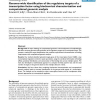BMCBI
2005
13 years 11 months ago
2005
Background: With the exponential increase in genomic sequence data there is a need to develop automated approaches to deducing the biological functions of novel sequences with hig...
BMCBI
2005
13 years 11 months ago
2005
Background: A major challenge in computational genomics is the development of methodologies that allow accurate genome-wide prediction of the regulatory targets of a transcription...
BMCBI
2005
13 years 11 months ago
2005
Background: In the clinical context, samples assayed by microarray are often classified by cell line or tumour type and it is of interest to discover a set of genes that can be us...
BMCBI
2005
13 years 11 months ago
2005
BMCBI
2005
13 years 11 months ago
2005
Background: The evaluation of statistical significance has become a critical process in identifying differentially expressed genes in microarray studies. Classical p-value adjustm...
BMCBI
2005
13 years 11 months ago
2005
Background: Different classes of haplotype block algorithms exist and the ideal dataset to assess their performance would be to comprehensively re-sequence a large genomic region ...
BMCBI
2005
13 years 11 months ago
2005
Background: Protein sequence motifs are by definition short fragments of conserved amino acids, often associated with a specific function. Accordingly protein sequence profiles de...
BMCBI
2005
13 years 11 months ago
2005
Background: Multiple genome alignment is an important problem in bioinformatics. An important subproblem used by many multiple alignment approaches is that of aligning two multipl...
BMCBI
2005
13 years 11 months ago
2005
Background: Recent studies have shown that the patterns of linkage disequilibrium observed in human populations have a block-like structure, and a small subset of SNPs (called tag...
BMCBI
2005
13 years 11 months ago
2005
Background: Human heart failure is a complex disease that manifests from multiple genetic and environmental factors. Although ischemic and non-ischemic heart disease present clini...





